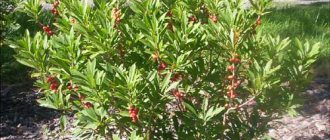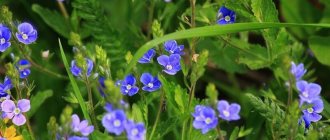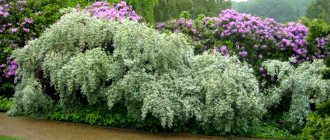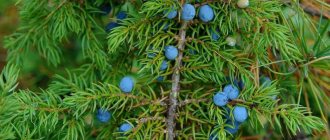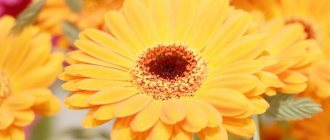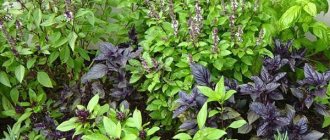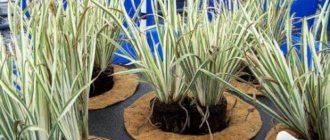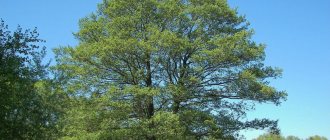Author: Elena N. https://floristics.info/ru/index.php?option=com_contact&view=contact&id=19 Category: Fruit and berry plants Published: August 13, 2017Last edits: November 02, 2020
- Beneficial features
Lingonberry (lat. Vaccinium vitis-idaea) is a species of the genus Vaccinium, an evergreen berry shrub common in forest and tundra zones. In nature, lingonberries grow in peat bogs, in coniferous, mixed and deciduous forests, in lowland and mountain tundras. It can be found in the European part of Russia, Western Europe, East Asia, Northern Mongolia, Manchuria and North Korea. The species name translated from Latin means “grapevine from Mount Ida” - this place is located on the island of Crete. The name of the genus was first mentioned in sources of the 16th century, and the plant was introduced into cultivation more than 100 years ago in America. At the same time, the first varieties of lingonberries appeared. In Europe, the plant began to be introduced into cultivation in the 60s of the last century. Today, common lingonberry, or medicinal lingonberry, is grown on an industrial scale in countries such as Belarus, Lithuania, Germany and Russia. Lately, lingonberry plantations have also appeared in Scandinavian countries.
Planting and caring for lingonberries
- Flowering: May-June.
- Planting: spring and autumn.
- Lighting: bright light.
- Soil: peaty, sandy loam, loamy or peaty-sandy soils with a pH of 3.5-5.5.
- Watering: throughout the season, 2 times a week, using 10 liters of water per m² of bed. If it rains, you can water less often. Irrigation method - drip or sprinkling. Once every three weeks, an acidifier is added to the irrigation water - acetic, oxalic or citric acid.
- Feeding: the first two years only with ammonium sulfate and superphosphate. Complete mineral fertilizer is applied once every five years.
- Pruning: in the spring before the start of sap flow, or in the fall during the leaf fall period, sanitary cleaning of the bushes is carried out, and not in the seventh year, anti-aging pruning is done.
- Reproduction: green and woody cuttings, dividing the bush and seeds.
- Pests: leaf beetles, leaf roller and copperhead caterpillars.
- Diseases: rust.
- Properties: lingonberries have medicinal properties and tonic, anthelmintic, antipyretic, wound healing, tonic, antiscorbutic, laxative, diuretic, choleretic, diuretic and disinfectant effects.
Read more about growing lingonberries below.
Reproduction
Lingonberries reproduce vegetatively, as they are prone to overgrowth (within fairly reasonable limits). For initial planting, it is best to use ready-made planting material from specialized nurseries; in the future, you can obtain new plants by cuttings and using seeds. The vegetative method of propagation is considered more preferable.
Seed germination is low and does not exceed 50% (according to some data - no more than 11%). In addition, the first berries from such specimens can be obtained no earlier than in 5 years. In wild conditions, this indicator is 3-4 times longer.
Propagation by cuttings is carried out according to the traditional scheme. In addition, you can divide adult bushes with rhizomes.
Botanical description
Garden lingonberry is a shrub with a height of 2.5 to 25 cm. Its cord-like greenish-brown rhizome up to 18 cm long with sparsely located short and thin roots lies at a depth of 2-10 cm. Shoots with light hairy branches extend from the rhizome. The leaves of lingonberry are perennial, leathery, elliptical, with a curled edge, 5-7 cm long and 3 to 12 cm wide, arranged alternately on short pubescent petioles. The upper side of the leaf blade is dark green, the lower side is much paler, with dark brown glands. Pale pink bell-shaped flowers with a toothed calyx, on reddish pubescent pedicels, are collected in 2-8 pieces in a thick drooping cluster at the ends of last year's branches. It is characteristic that the flowers located at the base of the shoot are one and a half to two times larger than the flowers in the upper part. Lingonberries are pollinated mainly by bees and bumblebees. The lingonberry fruit is a bright red multi-seeded, almost spherical berry with a diameter of up to 12 mm. Lingonberries bloom in May-June and bear fruit in late summer or early autumn. Very often on one bush you can simultaneously see both flowers and lingonberry berries.
Lingonberry is a relative of such crops as blueberries, blueberries and cranberries. Lingonberries are particularly similar to cranberries, but lingonberries have smaller, denser berries and are not so sour.
Habitat
Wild lingonberries are found in the tundra, forest and arctic zones of the temperate climate zone in North America, Scandinavia, the Netherlands, Sweden and Greenland. The domestic territories of the Caucasus, the Urals, Siberia and the Far East are famous for the spread of colorful plantations. The territories adjacent to Novgorod and St. Petersburg are leaders in terms of berry procurement volumes.
Tender twigs feel comfortable among the heather and swamps. Usually the plant clusters densely in small areas, but a bush creeping uphill can also be solitary. The berry especially likes light coniferous forests, where it thrives in the lower plant layer. Despite its apparent unpretentiousness and durability, lingonberry shoots do not like to grow in complete shade.
For comfortable growth of the plant, sandy loam soil is preferred, although swampy soil is also suitable.
To thrive, lingonberries do not need heat; the bushes are frost-resistant down to -22°C. It tolerates cold perfectly and is not afraid of snow, which performs the useful function of a fur coat for the plant, under which it is warm and comfortable.
But lingonberries cannot do without moisture.
In many areas of distribution, the berries are collected and imported on an industrial scale (for example, in Canada a record was set for the volume of collection - 96.5 tons).
Planting and caring for lingonberries
How to plant in the garden
The obvious and indisputable advantage of lingonberries is that they can be grown in any well-lit corner of the garden with a flat surface. In an area with uneven terrain, where cold air stagnates or water accumulates in depressions and hollows, lingonberries will develop worse. The crop is undemanding in terms of soil composition: sandy loam, loamy, peaty or peaty-sandy soils with high acidity (pH 3.5-5.5) are suitable for it. If you want the maximum return from lingonberries, create the soil for it on the site yourself: remove a layer of earth 25 cm deep and fill the hole with high-moor peat or a mixture of any peat with sand, adding sawdust, fallen pine needles or tree bark. Compact the surface of the bed and spill it with acidified water at the rate of 10 liters per m². As an acidifier, you can use citric or oxalic acid (1 teaspoon per 3 liters of water), as well as acetic or nine percent malic acid (200 ml per 20 liters of water).
- Eggplants: how to form bushes, water and feed
One- or two-year-old lingonberry seedlings are planted according to a 30x40 cm pattern, deepening them by 2 cm. If you are planting the crop for decorative purposes, you can place the bushes at a distance of 20 cm from each other: when the seedlings begin to grow, their crowns will close together, forming a continuous covering . After planting, the surface is compacted and watered, and after the water is absorbed, mulch made from wood, bark, straw, sawdust, pine needles or sand is distributed between the bushes. You can even use gravel for this purpose, but the best mulch for lingonberries is sawdust or wood shavings. The thickness of the mulch layer should be about 5 cm.
How to care for lingonberries
You will have to water the lingonberries twice a week throughout the growing season, spending about 10 liters of water for each m² of bed. However, rainy weather can make adjustments to the watering regime. It is best to organize drip or drip irrigation for the plant after sunset. Once every three weeks it is necessary to add an acidifier to the water. The next day after moistening the soil, you need to loosen the rows with simultaneous weeding.
Mineral fertilizers for lingonberries must be applied with caution, as they can even harm the plant. Lingonberries need to be fed carefully and in a timely manner: in the first two years of life, one teaspoon of ammonium sulfate and superphosphate is added to each m² of bed. Completely enrich the soil with complex fertilizer once every five years.
From time to time you should thin out the lingonberry bushes when it begins to seem to you that they have begun to grow too thickly. In the seventh year, you need to carry out anti-aging pruning, shortening all shoots at a height of 4 cm. This is done in early spring, before the sap begins to flow, or in late autumn, after harvesting. Within a year the plant will begin to bear fruit fully.
Lingonberries are damaged by leaf beetles and caterpillars of leaf rollers and honey beetles. These pests are collected by hand or repelled by spraying the berry thickets with an infusion of dandelions, onion peels or tobacco. In case of mass infestation of insects, use Ambush or Actellik solution. Sometimes lingonberries suffer from fungal diseases, in particular rust, causing its leaves and shoots to turn brown and dry out. You can cope with the infection with the help of pesticides Cuprozan and Topsin, but during processing you should strictly follow the dosage, sequence and precautions specified in the instructions.
Lingonberry is a northern berry, therefore it is resistant to both frosty and snowless winters. She is only afraid of returning spring frosts during flowering. Monitor the weather forecast and when it gets colder, cover the bed with berries with lutrasil or any other non-woven material.
- How to save summer seedlings - save until planting
Wintering
The berry is winter-hardy and can easily tolerate significant drops in temperature under snow (down to -30C and below). Despite the fact that it remains to overwinter with foliage, it does not suffer due to the low growth of the bushes. In addition, mulch also retains heat, so no special shelter is required in winter. However, there is a danger of bushes freezing in early spring, after the snow melts, if frost returns. In this case, it is recommended to have lutrasil on hand so as not to lose the entire future harvest.
Lingonberry collection and storage
Typically, lingonberries are harvested in August-September after the berries reach full ripeness. Due to the high content of benzoic acid in the fruits, they are well stored throughout the winter in wooden and ceramic containers, filled with water or weak sugar syrup. For longer storage, berries need to be dried or canned. Frozen lingonberries are well stored: ripe berries are washed, allowed to dry, placed in plastic bags or containers and placed in the freezer.
Habitat of growth: in which countries and regions can this berry be found?
Lingonberries are distributed circumboreally, that is, they grow throughout the taiga and forest zones of the northern hemisphere on both continents - both America and Eurasia. In fact, its habitat forms a kind of “belt” in the northern part of the planet:
The range of lingonberries when looking at the planet from the north pole.
The northern part of its distribution areas runs along the coast of the Arctic Ocean and its individual islands. The northernmost point of its discovery is the community of Kaasuitsup and the environs of the American military base of Thule in Greenland, located 1,100 km from the North Pole.
The southern border of the natural distribution area of lingonberries runs along the southern border of the taiga zone of Eurasia and Canada, but in separate branches the range descends to the south in the Carpathians and the Balkans. Isolated populations were found in the Caucasus, northeastern Turkey and southern Georgia, northern Spain and southern France.
It is interesting that lingonberries, grown in garden plots in areas remote from the main geographical area, are often propagated by seeds and spread by birds eating the berries, introduced into nature and take root here. This is how its range constantly expands and appears far from the main places of distribution.
For example, today there are known finds of lingonberries in China (apparently, the plant spread from Primorye), in Krasnodar, Moldova and in the southeast of Ukraine. There is also an increase in the presence of the plant in those regions of Russia where lingonberries were previously relatively rare - in the Samara region, Voronezh, and southern Bashkiria.
As you can see, lingonberry is a fairly plastic plant from an ecological point of view, capable of growing in various biotopes in which its basic requirements are met: warm, dry summers, lack of competition with other plants and reliable protection from frost and wind in winter. If such conditions are created in the garden plot, then here too the plant will grow and bear fruit quite safely.
Types and varieties of lingonberries
Currently, there are about 20 varieties of lingonberries. The most popular are:
- Coral is a compact spherical bush with a diameter and height of about 30 cm, bearing fruit twice during the season - in July and September. This is a high-yielding variety of Dutch selection, whose pink or bright red berries weighing up to 0.3 g have a classic sweet and sour taste;
- Mazovia is a low-growing, almost groundcover plant with dark red, sour berries weighing up to 0.25 g. This is a Polish variety that bears fruit twice per season;
- Erntesigen is a German variety up to 40 cm high with light red berries that are very large for the crop, reaching 1 cm in diameter. The fruit has a sweetish-sour taste;
- Erntekrone is a medium-sized plant up to 20 cm high with large, dark red, sweet-sour berries weighing an average of 0.4 g, which ripen twice per season;
- Ruby is a late-ripening variety up to 18 cm high with dark red sweet and sour fruits weighing about 0.2 g;
- Kostromichka is a variety that produces a harvest only once per summer - in mid-August. The fruits of this lingonberry are dark red, 7-8 mm in diameter, with a sweet and sour taste;
- Ida - spherical dense bushes 15-20 cm high with early ripening bright red berries weighing 0.5-0.8 g. The repeated harvest ripens in September;
- Sanna is a variety with erect shoots 15-25 cm high and round red fruits weighing 0.4 g, ripening in August;
- Kostroma pink - evenly branched bushes about 25 cm high. The variety is mid-season, self-fertile. Dark red fruits with a diameter of 7-8 mm ripen in the second ten days of August.
In addition to those described, the lingonberry varieties Erntedank, Red Pearl, Suzy (Sussi), Runo Belyavske, Scarlett, Red Emmerland, Linnea and others have proven themselves well.
Leaves
The leaves are the subject of special lingonberry pride. The leaf arrangement is alternate in two rows on short cuttings. But the platinum sheets themselves are simple elliptical in shape, leathery, and voluminous. Dimensions of the average leaf: 0.5-2 cm in length, 0.4-0.9 cm in width. When viewed up close, it is shiny, smooth, and dark green on top. And the underside is grayish, dotted with dark glandular hairs, fleecy to the touch. The oblong leaves are curved back, creating an elegant look for the plant, coupled with bright berry accents.
Properties of lingonberries - harm and benefit
Beneficial features
The medicinal properties of lingonberries have been known for a long time: our great-grandfathers called it “the berry of immortality” because it cured many ailments. The berry is valuable primarily for its high content of vitamins A, E, B and C. The composition of lingonberry fruits also includes organic acids (citric, malic, oxalic, benzoic and salicylic), minerals such as manganese, magnesium, potassium, iron , calcium and phosphorus, as well as starch, mono- and disaccharides, flavonoids and other substances necessary for the human body.
Interestingly, the beneficial properties of lingonberry leaves are valued no less than the properties of the berries: they also contain a whole range of important substances, and first of all, the natural antiseptic arbutin. Today, lingonberry leaves are used for medicinal purposes even more often than its fruits. This is due to the fact that they are easier to harvest, transport, and they are stored longer than berries without loss of quality. Lingonberry leaves have a tonic, anthelmintic, antipyretic, wound-healing, tonic, antiscorbutic, laxative, diuretic, choleretic, diuretic and disinfectant effect.
Lingonberry is an excellent assistant in the treatment of coronary heart disease due to the content of chromium, copper and mineral salts in its berries. It lowers glucose levels and is recommended for people with high blood sugar. Lingonberries are indicated during pregnancy: its juice is taken for neuroses and anemia, which often accompany women during this period. The use of lingonberries at low acidity of gastric juice has a beneficial effect on intestinal motility.
Plant preparations are popular in folk medicine: a decoction of lingonberries quenches thirst during fever, and a decoction of its leaves is taken for diabetes, kidney disease, gout and rheumatism. Lingonberry tea (lingonberry leaves brewed with boiling water) relieves fatigue and restores strength.
- Cherries: growing in the garden, types and varieties
It has been proven that lingonberries enhance the effect of sulfa drugs and antibiotics, so lingonberry juice is prescribed for fevers and to increase appetite after a serious illness.
Contraindications
Contraindications for lingonberry leaves apply to children under 12 years of age and people with high acidity of gastric juice. In addition, hypotensive patients should take lingonberry leaf preparations with caution and for no longer than 2-3 weeks, after which they should take a break for 2 weeks. This is due to the fact that due to the strong diuretic effect of the drug, blood pressure can drop sharply.
As for lingonberry berries, it is undesirable to use them for gastritis with high acidity and stomach ulcers, and due to the thinning properties of lingonberry preparations, they are contraindicated for postoperative patients and patients with internal bleeding.
Lingonberries have one bad property: they, like no other plant, are capable of accumulating radioactive and toxic substances, so you can only eat berries that grew far from roads, cemeteries and industrial production.
How to grow from seeds
Plants grown from seeds bear fruit only in the 3rd–5th year. But this is a more budget-friendly method, since the seeds can be obtained from ripe berries at the end of autumn. Before seeds are sown, they must be stratified, a process in which the seeds are kept at low temperatures so they can germinate faster and more easily.
You can carry out stratification at home. To do this, the seeds need to be immersed in damp sand and refrigerated at 4 degrees for four months. After this, you can start sowing the seeds. To do this, you need to prepare shallow containers and fill them with peat mixture.
Did you know? Lingonberries are famous not only for their berries, but also for their leaves, which are used in the manufacture of antiseptics.
Make small furrows and sprinkle seeds without covering them with soil on top. The temperature should be about 20 degrees. The containers are covered with film and the soil moisture in them is constantly checked. After 2 weeks, the first shoots may appear. After 1 month, the film must be removed.
Name Feature
In Latin, lingonberry is called Vaccinium. The name comes from another Latin word - baccinium, which translated into Russian means a bush of berries. According to the species name of this crop, in Latin it is called vitis idaea. Translated: Ida grapes. In more understandable terms, grapes from Mount Ida. This mountain is located on the Mediterranean island of Crete. Essentially, this is Greece, which has never been known for its swampy terrain. Strange, isn't it? Especially when you consider that the plant in question prefers precisely these growing conditions.
If you dig deeper, you can dot all the i's. According to ancient Greek mythology, the goddess Cybele was part of the pantheon of gods. She was in charge of fertility, and therefore wore a beautiful large wreath, into which branches of a variety of plants were woven. Including the stems of the lingonberry bush. Apparently, the scientists who gave the representative of the forest flora an official name remembered this ancient Greek story - and forever associated lingonberries with the Greek goddess.
Residents of the Ancient World knew lingonberries and actively used them in cooking and medicine. Even the Roman poet Virgil mentioned the plant in his literary works.
External signs of the plant
Flowers:
main color pink, white; perianth fused-petalous; size up to 1 cm; shades of white colors; main color red; number of petals 4; perianth actinomorphic; shades of red colors; inflorescence raceme.
External signs of leaves:
leaves are simple; the surface is leathery; the base is round; the edge is folded, crenate (barely); round shape; there is no division; obovate shape; surface of the gland (spots on the lower surface); the base is wedge-shaped; edge serrated (finely toothed), smooth; petiole attachment; oval or elliptical shape.
Differences between shoots:
leaf arrangement on the shoot is alternate; shoots erect, lodging; placement of leaves along the length of the stem; shoots are creeping or recumbent, ascending.
Fruits: color with shades of white; juicy type; color with shades of red; juicy berry.
Story
The first mention of lingonberry cultivation dates back to the 18th century and dates back to 1745.
In a decree that has survived to this day, Empress Elizabeth ordered lingonberry bushes to be planted in the Tsar’s Garden, and also to use the plant for landscape design of Peterhof. Of course, in those distant times there was no such thing as “landscape design”, but this does not change the meaning of the empress’s decree. Garden master B. Fok had to replace other plants with lingonberry bushes that were not able to withstand the autumn frosts. However, this was rather a prehistory to the cultivation of lingonberries than the story itself. The main work in this direction started in the 60s of the last century. The Americans were the first to begin cultivating lingonberries, and almost simultaneously with them, German, Polish, Finnish, Dutch and Swedish botanists and breeders devoted themselves to the same business.
- 1940. In the Federal Republic of Germany, more than 40 hectares of land were allocated for the creation of lingonberry plantations. The Germans developed a whole mechanized complex that cultivated the land planted with lingonberries, and after the berries ripened, they harvested them.
- 1980s: “Cultivated” lingonberries appeared in Belarus, Lithuania and that part of the Soviet Union that is today the Russian Federation.
If we compare the yield of wild lingonberry thickets with cultivated plantations, the yield of the latter will exceed the yield of the former by 30 times. One hundred square meters planted with lingonberry bushes can produce up to 60 kg of fruit per year.



